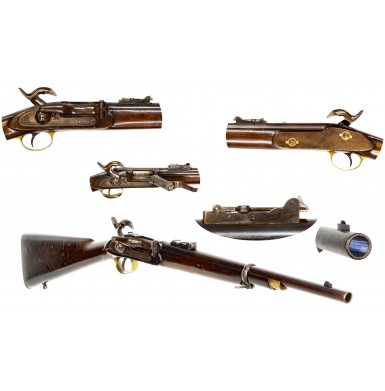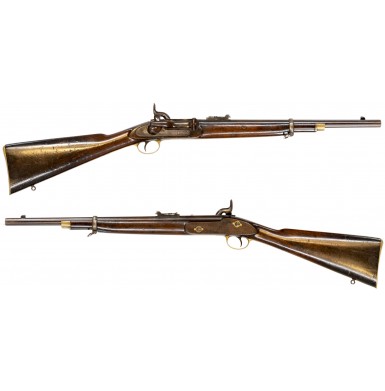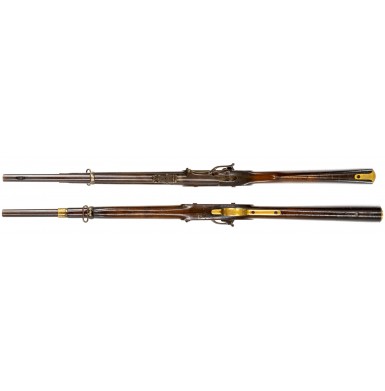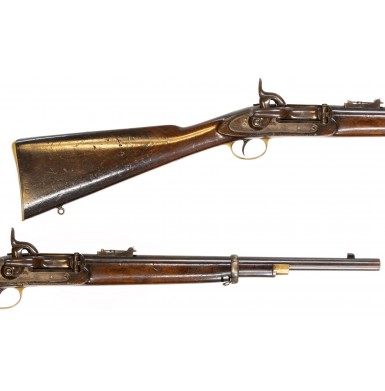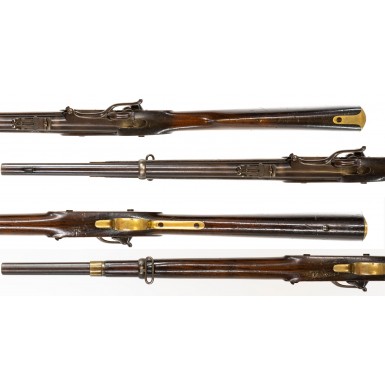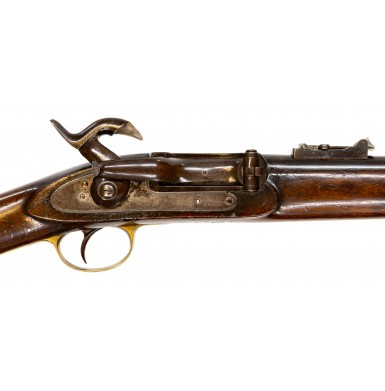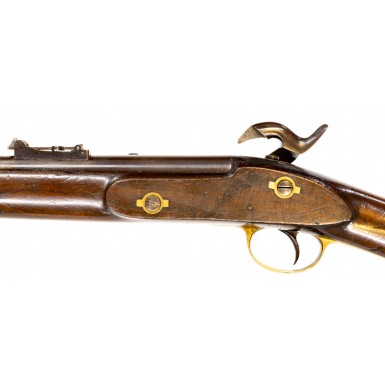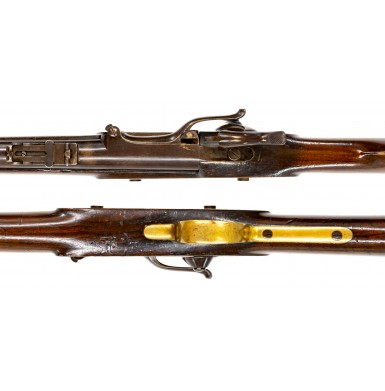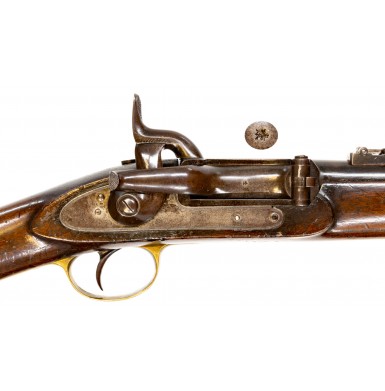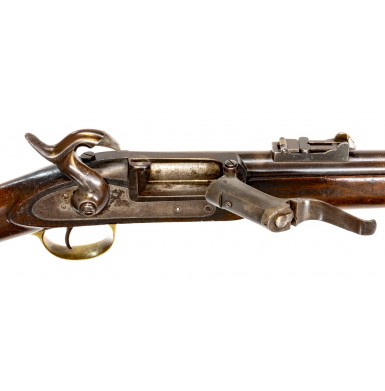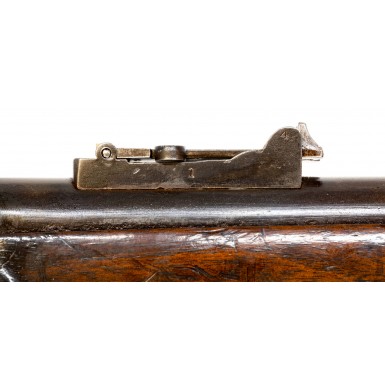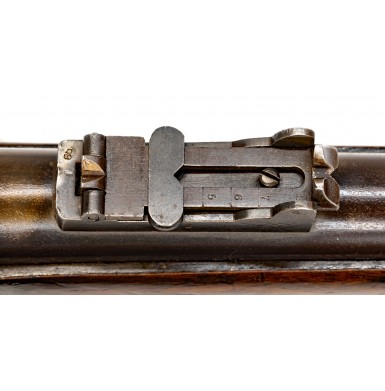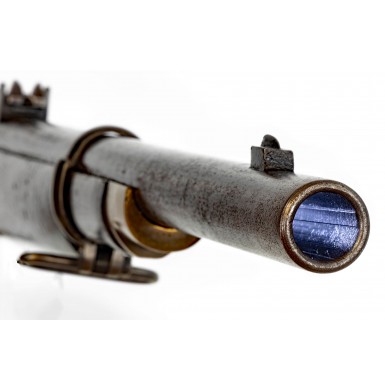British 1867 Breechloading Trials Submission Rifle by Needham
- Product Code: FLA-4002-SOLD
- Availability: Out Of Stock
-
$4,500.00
The rifle offered here appears to be one of the trials rifles submitted by Joseph Needham for the British Military’s 1867 Ordnance Select Committee’s Breechloading Rifle Trials, which were known more colloquially by students of British military arms as the “Prize Competition”. This set of trials had been established by the War Office for the specific goal of determining the best possible breechloading rifle design to take into service. The prior year the Snider-Enfield system had been adopted as the best method by which existing stocks of muzzleloading Enfield rifles and muskets could be altered to cartridge breechloaders, but it was not clear that the Snider system was the best “purpose built” system and as a result new trials were ordered. Based upon an examination of the historical record and the extant arm it is my belief that this is Sample #2 submitted by Joseph Needham for the 1867 trials. In order to understand these trials more fully, it is first necessary to understand the genesis of the trials that preceded them and the thinking that pervaded the War Office as the War Department looked at the feasibility and advisability of adopting a breechloading firearm for general issue.
In 1864 the British military decided in principle that it would be necessary to adopt a breechloading rifle for use by the infantry in order to remain on par with other military powers around the world. The Prussians had adopted the Dreyse designed Zündnadelgewehr (Needle Gun) in 1841 and some two decades later were already issuing the 2nd generation of that breechloading bolt action rifle, in the form of the Model 1862. In America, breechloading firearms using self-contained metallic cartridges were seeing use in the American Civil War, some of which were also repeating firearms like the Henry Rifle and Spencer Rifles and Carbines. The British Ordnance Select Committee on Breechloading Small Arms that studied the subject of breechloading arms for general issue from 1859 to 1864 summed up their conclusions on 11 July 1864 with the following statement:
“The committee, composed of practical officers, unanimously report in favour of arming the infantry with breech loading rifles. The question must be dealt with in two ways – either by ascertaining the speediest and cheapest mode or by determining the most perfect arm to be used by the infantry. We must first adopt the readiest means for converting existing arms of service. Having thus armed the troops, we should proceed to enquire fully and deliberately what form of rifle would be most perfect.”
With that statement, the beginning of the developmental and testing process that would result in the adoption of the British Snider-Enfield Rifle began.
The journey was fraught with numerous trials and tribulations and involved two major test evaluations of competing designs, as well as numerous lesser tests of specific features and involved ammunition development as well. Most of that complicated story is outside the scope of this description, but it is worth noting that the British military sought to find the “most perfect arm” from a selection of relatively new designs rather than relying on designs already adopted by other powers.
The reason for this was that the British felt that no breechloading designs currently adopted were satisfactory for one of two reasons, either the system leaked gas which was objectionable to those in command, or the system did not utilize ammunition that was considered powerful enough for use as a line infantry rifle. Examples of the first issue were the Prussian Needle Rifle and the American Sharps, as both leaked gas from the breech when fired and did not provide any form of positive gas seal. Even the French Chassepot design which included a rubber obturator to solve the Dreyse needle gun’s gas leakage issue was not considered a viable option as the rubber gasket failed after repeated firing and had to be replaced, sometimes as often as every thirty rounds. In the case of the second objection, self-contained metallic cartridges like those used with the American Henry and Spencer rifle designs solved the problem of the gas leakage as the cartridge casing provided the gas seal but were not considered powerful enough for British military service. The committee clearly wanted a design that was capable of solving both the gas sealing issues and could provide downrange power equivalent to the current issue muzzleloading Pattern 1853 Enfield Rifle Musket. They also preferred a self-contained cartridge design, rather than one that relied upon external ignition, like many of the “capping breechloader” designs that proliferated in Great Britain and America during the mid-19th century.
Early, somewhat informal experimentations by the committee during 1860 and 1861 found that many of the currently available designs and potential designs were problematic. Two systems that were examined were those by Wilson and Montgomery Storm. The Wilson design, while elegant and simple to operate, was hampered by the fact that it was a capping breechloader and had accuracy issues that were the result of the greased wad at the base of the bullet that was used to create a gas seal in the chamber. After the first round was fired this wad was left behind in the breech and if it were not removed was subsequently fired out of the bore on the next shot, on the nose of the next bullet. This led to erratic accuracy. The Mont-Storm system was also an externally primed capping breechloader and while it was a design that offered potential for use as a means of altering muzzleloaders to breechloaders it too was hampered by less than stellar accuracy. Of the various early tests, only the design submitted by Jacob Snider was considered truly promising.
In order to discover what design would be the best to start the alteration of existing muzzleloading Enfield rifles and rifle muskets to breechloaders, the Secretary of War released a request for trial submissions on 23 August 1864. The request read in part that the War Department sought to “receive communications from gun-makers and others on the subject of the best means of converting the Enfield rifle into a breech-loader.” There were two primary criteria for all designs that were to be submitted, first that that the altered firearms “should not be inferior to that of an unaltered arm when shooting” and that the per unit alteration price should “not exceed the cost of £1” Sterling per firearm. In order to motivate the best and brightest innovators in the field of firearms designs, the winning submission would be awarded the sum of £5,000 for the use of the design, essentially a flat rate royalty payment. The potential to win the large cash award resulted in 43 firearms designs being submitted by the end of September with a final total of 47 designs submitted by mid-October. A preliminary inspection of the designs and concepts resulted in more than half of the submissions being rejected out of hand with no actual testing. A total of 9 were selected for full testing and 11 more were designated for “reconsideration” which meant they were analyzed for potential design ideas and improvements to current designs but were not being considered as part of the actual trials.
The 9 designs that were immediately selected for testing were those submitted by Dixon, Montgomery Storm (Mont Storm), Shepards (a), Westley Richards, Wilson, Green, Snider, Joslyn and Shepards (b). Dixon withdrew his design before testing commenced, so the field was reduced to 8 possibilities. Of those, the first five designs were “capping breechloaders” and as such the committee was biased against them, preferring a self-contained metallic cartridge to percussion ignited one. Of those 3 designs, the following notes were made:
#6 Sinder’s – New system. Very simple conversion that dispenses with percussion caps.
#7 Joslyn’s – First noted in 1861 trials. Hinged breech partially ejects empty cases.
#8 Shepards’ (a) – First noted in 1864 trials, breech locks in the centre of the stock. Only original part retained is the barrel.
The other potential designs included submissions by Adams, Clark, Manceaux, Goodman, Benjamin, “Colonel C” (two submissions), Matthew, Wentworth, Storer and Needham. Most of these designs were rejected as being too complicated, too delicate, or due to gas leakage.
The trials began in earnest at Woolwich on 6 February 1865. At that time the Shepards was rejected as the cartridges for the gun were so delicate that they fell to pieces when picked up. As such the design was rejected without firing. Another competitor fell by the wayside as the shipping of the American designed and manufactured Joslyn Rifle was held up in New York due to a failure to obtain the necessary export permits. As a result, the Joslyn design was rejected out of hand as well. This meant that the only self-contained cartridge design to remain in the competition was that of Jacob Snider. Considering the committee’s known bias towards the self-contained cartridge design, it would be fair to say that the committee’s decision was made at this point, for all intents and purposes.
The trials did, however, continue with the designs of Green, Wilson, Mont-Storm, Westley Richards, and Snider. When compared to the muzzleloading Enfield all of the guns provided a substantially higher rate of fire, with the submissions firing two to three times faster than the muzzleloader in a comparison of how long it took the guns to fire twenty aimed shots at a 100-yard target. The Enfield required just shy of 7 minutes to complete the task, coming in at 6:52. The Green design was the fastest, completing the course of fire in less than 2 ½ minutes with a score of 2:26. The Snider was slightly slower, completing the course of fire in 2:46. Issues with faulty Snider ammunition resulted in some additional time to load and unload and when better quality ammunition was later substituted in subsequent trials, the time improved to 2 minutes flat, making it the fastest of the submissions.
However, problems started to arise when accuracy was tested. As the submission requirements specified that the designs had to be equal to or superior to the current issue firearm, the failure of all the submissions to achieve the same level of accuracy of the Pattern 1853 Enfield Rifle Musket was problematic. Based upon rifle accuracy tests that were conducted by the committee on 6 February 1865, the Enfield achieved an accuracy deviation of 1.64-feet at 500-yards, which was better than all of the submissions. The next best accuracy was achieved by the Westley Richards design at 1.81-feet, followed by the Wilson design at 2.10-feet. The Mont-Storm design achieved a deviation of 2.58-feet, the Green design a deviation of 3.59-feet and the Snider design resulted in a deviation of a dismal 5-feet! Again, as with the earlier speed tests, it was determined that the Snider’s issues were likely ammunition based. When the ammunition was later redesigned by Colonel Boxer and was tested in the Snider, it was capable of exceeding the accuracy of the Pattern 1853 Enfield by achieving a deviation of only 1.06-feet at 500-yards.
Initially the Snider also performed poorly in the reliability testing. In a course of fire of 270 rounds, the Snider had the highest failure rate with eight misfires. The control standard Enfield only had one misfire, as did the Wilson and Westley Richards designs. The Green and Mont-Storm designs suffered no misfires. Again, the issue was resolved when the Snider was tested with newly improved ammunition. In later testing the Snider fired 5,500 rounds with only a single misfire. The fact that the British War Department put time, effort, and money into the redesign of the ammunition for the Snider system certainly suggests that the “fix was in” and the committee wanted Jacob Snider’s submission to be successful. Interestingly, no such effort was made to develop or improve the ammunition of the other design submissions.
Interesting, in the end (and despite the heavy hand of the judges on the scale) the Mont-Storm system was initially adopted as the system by which the British military would alter their existing inventories of Enfields to breechloader. However, the Mont-Storm had a fatal design flaw that the committee did not consider. The hinged breechblock flipped forward for loading and cartridge was inserted in a chamber in the breechblock, rather than in a chamber in the receiver of the gun. That meant that the cartridge had to be inserted “backwards”, with the nose of the bullet facing the soldier, when it was loaded. When the breechblock was closed it flipped over and then the cartridge was correctly oriented. In field trials the British soldier could not reliably load the Mont-Storm action correctly and the incorrectly inserted cartridges failed to fire. It was considered that this problem could be overcome with a regimen of intensive training, but this plan was discarded due to a secondary design problem. Durability issues with the combustible skin cartridge used in the design presented the second major problem. As a result, after only about 2,000 of the initial 3,000 Mont-Storm alterations were completed, the system was abandoned.
The committee then reverted to their original preference, the Snider design, but was concerned about the ammunition issues that had arisen during the initial testing. At this point, Colonel Boxer was tasked with reinventing the cartridge to provide the required reliability and accuracy. This he did and on 23 May 1866 the Snider design was officially recommended by the Ordnance Select Committee as the system by which to alter the existing stocks of Enfield Rifles and Rifle Muskets to cartridge breechloaders. The new design was officially described by the War Department as “Change 1327, Musket Rifled, Pattern 53 Converted to a breech-loader on Snider’s principle (Pattern I).” In service this would be known as the Snider-Enfield MkI. Due to issues with the breeches opening when fired, a change to the machining of the breech recesses was adopted as the MkI*. In 1869 a breechblock locking latch would be adopted to further resolve that issue and the new alteration design designated as the Snider-Enfield MkII. Additional improvements to the alteration system were subsequently designated as the MkII* and MkII**. Within about two and half years the existing stocks of Enfields that were suitable for alteration to the Snider system were used up. As a result, on 13 January 1869 newly made Snider-Enfield MkIII Rifles and Rifle Muskets began to be produced. These were purpose-made breech loaders and were not conversions from muzzleloaders as the MkI and MkII guns were.
This was only the first step on the road to the adoption of a breechloading cartridge rifle for the British military. Now that a means to alter the existing stocks of arms to breechloader had been adopted, it was time to find that elusive “most perfect” purpose-made breechloading design. In October of 1866, only four months after adopting the Snider system to alter muzzleloading arms, the War Office announced a new set of trials to find the best possible purpose-built breechloading rifle. The request for submissions required that the rifle be no longer than 51” in length, with a barrel of“uniform weight and length. Weight 4 lb 5 oz, length 35.” The total weight of the gun was not to exceed nine pounds, five ounces, and was to be able to deliver an accuracy deviation of no more than six inches at 300-yards and twelve inches at 500-yards. The rifle had to utilize a Boxer-primed cartridge that used 85 grains of Curtis & Harvey’s #6 powder. Although the caliber of the cartridge was not specified the basis requirements suggested a preference for the .577 Snider-Enfield cartridge. The rifle also had to be able to mount a bayonet. As with the earlier trials, cash prizes were offered to encourage competition. These awards included £300 to all of the designers who passed the first stage of trials to help finance the manufacture of six additional experimental rifles, £1,000 if the design was selected for military use and £600 to the best design that was not adopted. Additional awards included £400 for the best cartridge design and £300 for the best magazine fed repeating rifle design.
As of 21 March 1867, 104 different submissions had been received by the committee. Of those guns, 37 were considered for further testing because they satisfied the design submission criteria and were designated as “Class I”. The balance of 67 were rejected as potential finalists for their failure to adhere to the design specifications and were designated “Class II”. However, many were subsequently studied to “discover any merits” that the designs might have had. Of the 37 that had passed the initial cursory inspection for adherence to the design specifications, 21 were disqualified for various reasons before they were ever fired and seven more were disqualified after firing only twenty cartridges. That left only 9 contenders, who were officially listed as finalists on 21 March 1867. These designers were then allocated £300 each for the production of six test rifles. The 9 finalists were the designs from Albini-Braendlin, two from Burton (designated 1 & 2), Fosbery, Alexander Henry, Joslyn, Martini, Peabody, and Remington.
By the time the Class II arms were being looked at for their “merits” in July of 1867, the group of 67 had grown to 83. The Class II arms were then further sorted in List A, B and C arms. The arms placed on List A were rejected out of hand and no further testing was performed. This list totaled 68 guns, one more than original number of guns designated as “Class II”. Four arms were placed on List B and were considered “warranted a further examination but were subsequently rejected.” The arms placed on List C included eleven arms that were “set aside for further consideration.”
Interestingly the testing of the Class I submissions, against a Snider Enfield resulted in somewhat embarrassing results. In general, the Snider was more accurate and fired as quickly or more quickly than the new submissions. In fact, none of the new submissions were capable of achieving the accuracy standards set in the submission proposal. In the end, the 1867 trials resulted in the conclusion that for the time being no submission was significantly superior to the Snider-Enfield then in service, and a new rifle would not be adopted until 1871, when the Martini-Henry (Peabody) design would be adopted. It appears that the most important discovery that came out of the 1867 trials was that the reduced caliber Henry projectile with a longer bearing surface provided substantial ballistic advantages over the .577 Snider cartridge and when the new Martini-Henry rifle was adopted it would be in the .577-450, reduced caliber chambering.
The point of the long discussion of the various arms submitted for testing in these trials is to provide the background information for the rifle offered for sale here, which appears to be one of Joseph Needham’s submissions for the 1867 trials. Needham had submitted a “needle rifle design” during the first set of trials which selected the Snider system. This time he submitted three sample, rifles, all apparently based upon the same principle. The description of his system is quoted from the portion of the Select Committee’s report regarding the Class II, List C guns “Systems Retained for Further Consideration”. It reads as follows:
Needham – This rifle is adopted for the Boxer central-fire cartridge. The barrel is prolonged at the breech by a cylinder opened at the right side. The breech is closed by a block opening out laterally on a vertical pivot at the forepart of the open cylinder. The extractor is a lever of the first order on the vertical pivot and is worked by the action of opening the breech. A pistol passed through the action of the breech block, and is forced forward by a peculiar wedge-shaped hammer, worked by a common lock. The hammer also answers the purpose of a locking bolt, and prevents breech being blown open.
Remarks: 20-6-67, trials for accuracy and rapidity of fire all shot by Mr. Needham. The cartridges were easily extracted after firing. 12 shots in 59 seconds, without accident or delay.
The above report specifically deals with Needham’s entry #1, as his #2 and #3 entries are described earlier in the report where the guns that were rejected out of hand prior to testing are described. The report provides a brief account of these two rifles as follows:
Needham, Nos.2 and 3 – No.2 is too short and withdrawn by Mr. Needham. No.3 was rejected as being in an unfinished state.
The Needham Trials Rifle being offered here is in my opinion No.2 which was “too short”. The gun is built with modified Enfield pattern parts and could well have been created by modifying an Enfield. The gun is unmarked externally with the exception of a single post-1813 Birmingham proof mark on the breech chamber’s door. Internally the gun is marked inside the lock and on the bottom of the barrel with the initials J.N. which clearly indicated Joseph Needham, over the number 2, almost certainly indicating sample number 2. It is worth noting that at least some of the rejected submission in the trials were noted as having not been proved. In the case of the submission by Tronchon the report noted that it was “Too short and having no proof marks was not fired…”
The rifle has a 21.75” round barrel secured by a single barrel band and an overall length of 38”. While the 38” overall length meets the requirement that the gun is not to exceed 51” in length, the barrel itself is normally 13” short of the trial’s specifications, no doubt the reason for the “too short” rejection. The gun is chambered for the .577 Snider cartridge. The stock is 32 1/8” in length and the length of pull is 14”. The rear sight is a modified Pattern 1853 Enfield military ladder sight, with the sidewalls reprofiled to make the elevation adjustments correct for the .577 Snider ammunition, fired from the short barrel. There is a combination Enfield style front sight and socket bayonet lug located 1 ½” from the muzzle and the exterior muzzle diameter is .80”. This is very close to the standard Enfield positioning of nominally 1.4” for the muzzle to stud distance with an exterior diameter of nominally .79”. These dimensions indicate that Needham intended the rifle to accept the standard British military socket bayonet, in keeping with the design specifications for the trials. The breechblock is 2 ½” in length and opens by swinging outward and toward the muzzle, as is typical of all Needham action breechloading firearms. A traditional military style sling swivel is attached to the single barrel band and a sporting style sling ring is mounted in the toe of the stock about 2 ¼” from the butt.
The rifle remains in FINE condition and retains much of the period browned finish on the barrel. The finish had thinned, faded, and dulled with time but still covers more than 90% of the barrel with areas of wear and loss at the point of contact and handling, as well as around the muzzle. The metal remains mostly smooth throughout with only some evenly scattered pinpricking and lightly scattered minor surface oxidation over the entire barrel. The color case hardened lock and hammer have aged to a lovely mottle brownish patina with some light surface oxidation. The action remains in fine condition and functions smoothly and crisply in all manners. The bore is bright and fine with crisp rifling and shows only some moderate amounts of frosting in the grooves as well as some lightly scattered pinpricking. The stock remains crisp with fine edges throughout and shows no indications of having been sanded. The stock is full-length and void of any breaks, cracks, or repairs. The wood retains its original finish and shows only some scattered bumps, dings and mars from handling and use.
Overall, this is a really wonderful example of a British Military Trials Rifle – Needham’s No.2 from the 1867 Ordnance Select Committee Breechloading Rifle trials. While Needham’s design was never accepted by the British military and never really caught on or became a commercial success, his design does present an interesting footnote to 19th century firearms history. Some 5,000 obsolete US Model 1861/63 Contract Rifle Muskets were altered to the Needham system in the late 1860s for use by the Irish Nationalist Fenians during their second ill-fated attempt to invade Canada in May of 1870. The goal of the invasion was to protest the English rule of Ireland and to try to force the English to allow Irish autonomy and Home Rule. The irony that they were armed with rifles altered with an English-invented design that had also been submitted for British military trials is not lost on many historians. Rarely do trials rifles from such an important part of British military history appear on the market and it is reasonable to assume that other than submissions Nos.1 and 3, no other such Needham trials “Enfields” exist. Don’t miss your opportunity to add this wonderful trials gun to your advanced collection of British military or experimental arms.
SOLD
Tags: British, 1867, Breechloading, Trials, Submission, Rifle, by, Needham

